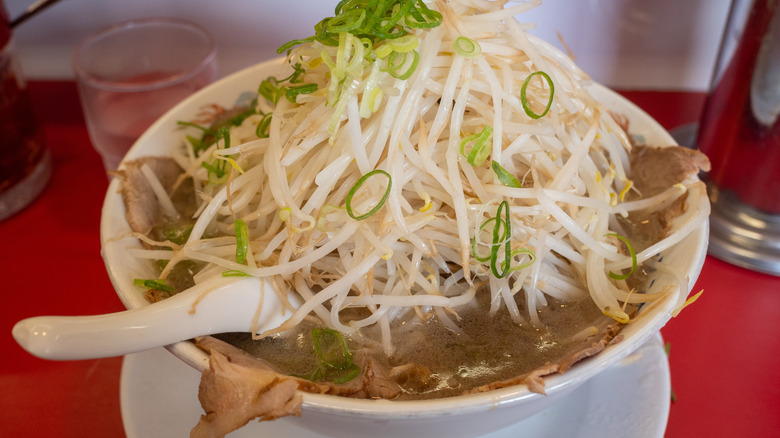8 Popular Restaurant Dishes That Are Most Likely To Make You Sick
Whether you're enjoying breakfast with the family, meeting a friend for lunch, or going on a dinner date, chances are you've dined out at a favorite establishment at least a few times in your life without issue. What happens when you suddenly fall ill after eating at a restaurant, though? It can be incredibly disheartening to make the connection and realize that something prepared there may be responsible for unwelcome symptoms like nausea, diarrhea, vomiting, and general digestive upset.
Sadly, if the experience makes you sick, you may not be so keen to dine at a restaurant again. Per the Centers for Disease Control and Prevention (CDC), some 48 million people in the United States contract food poisoning every year. While that's sometimes due to unwell workers showing up to prepare food anyway, a significant culprit is the food itself. Simply put, some ingredients are inherently riskier, leaving anyone who consumes them with a greater chance of developing a foodborne illness.
The good news is that arming yourself with knowledge can make a world of difference, helping you make smart choices when you're at a restaurant. In some cases, it's simply a matter of choosing food that's prepared a specific way over another way, which means you don't always have to avoid those delicious dishes you love. It's well worth recognizing where the risks are so you can avoid complications that range from a mild belly ache to more serious distress that, in some instances, can even land people in the hospital.
Eggs could potentially cause a salmonella infection
Eggs are a common food that can be prepared in many ways, including scrambled, fried, and poached. Eggs also occasionally feature quite prominently in other foods, like salads, baked goods, and mayonnaise. They can be deceptive because, according to the Food and Drug Administration (FDA), even those beautiful white eggs with not a single flaw on the shell could be harboring salmonella bacteria. Once infected, it takes only hours to develop symptoms that range from cramping to fever.
The CDC found that many food poisoning cases linked to eggs could be traced back to restaurants. The reasons were staggering: Some weren't cooked to the recommended 160 degrees Fahrenheit temperature, some didn't store uncooked eggs at a minimum of below 41 degrees Fahrenheit, some used unpasteurized eggs, and some didn't maintain clean and sanitized cooking utensils. All of this may be enough to convince you to prepare eggs in the comfort of your own home instead, but there are several steps you can take to ensure their safety if you're dining out.
The first is to inquire with the restaurant about their egg handling practices. If you're ordering a dish with house-made Caesar salad dressing, mayonnaise, or hollandaise sauce, for example, make sure that they use only pasteurized eggs. This is key to killing off the germs responsible for causing sickness. Avoid any type of dish made with undercooked, raw, or unpasteurized eggs. If the employee isn't sure, avoid the eggs to be completely safe.
Pre-cut melons could be contaminated with salmonella
Just say no to the pre-cut melons. Although they're often found in fruit salads at restaurants, the popular fruit seems to pose a considerable food poisoning threat. Explains James E. Rogers, PhD, who's a director of food safety research and testing at Consumer Reports, "When you cut into produce, you increase the risk of transferring bacteria that may be on its surface into its flesh. In commercial facilities, with fruits and vegetables processed in one place, it can create opportunities for cross contamination."
Naturally, melons aren't cooked either, so there's no chance that any bacteria present could possibly be killed off by heat. Food poisoning expert Bill Marler tells Business Insider that there's another issue with pre-cutting melons, too: It's a "[g]reat way to multiply bugs." Luckily, it's easy enough to avoid this in a restaurant setting simply by steering clear of any type of pre-cut produce whatsoever. According to Rogers, that includes fruit you may not necessarily consider big food poisoning culprits, like peaches and papayas.
The risks are too great, as melons can become contaminated with listeria, salmonella, or E. coli at any point from farming to preparation. Even if the fruit is properly handled, there's a chance that it may become contaminated with bacteria if it's placed on an unsanitary surface or isn't refrigerated at the right temperature. The best way around this is simply to purchase whole melons and cut them yourself at home under sanitary conditions.
Sprouts are a common cause of food poisoning
Sprouts are deceptive because they're quite nutritious. High in vital vitamins and nutrients, they are thought to be excellent for both gut and heart health. Unfortunately, because sprouts thrive in humidity, they provide an ideal breeding ground for listeria and other bacteria to grow. Even washing sprouts doesn't remove the contaminants, per the CDC, making it a challenge to enjoy them confidently. What's more, people tend to eat sprouts raw — it is very rare to find a dish with cooked sprouts on the menu!
Dr. Elliot Ryser, PhD, who teaches food science and human nutrition at Michigan State University, tells Good Housekeeping, "Sprouts are probably one of the one of the riskiest products in the produce section. That's one item I tend to avoid." And Travers Anderson, a group manager of research and development at Clorox, explains to Real Simple, "Contamination in these cases generally tends to come from the seeds."
Given the significant risk involved in consuming sprouts in their raw state, it's generally best to avoid them at restaurants. The statistics alone may be enough to convince you. The FDA found that between 1996 and 2016, at least 46 food poisoning outbreaks were attributed to sprouts, and those led to over 2,400 illnesses and over 180 hospitalizations.
Undercooked meat is a breeding ground for illness
Meat doneness is always a hot topic in the carnivore community. While flavor is usually the point of contention here, there's also the little matter of safety to consider — and, unfortunately for the purists of the world, there's an elevated risk of contracting food poisoning when the meat is undercooked. It opens the door for everything from salmonella to E. coli to Campylobacter.
The latter may not be the household name that the others are, but it's no less harmful. In fact, it's considered "one of the most common bacterial causes of diarrheal illness in the United States" (per the Minnesota Department of Health). The bacteria actually lives in the intestines of the animals, but can also be traced to food and water supplies contaminated by infected animals. Plus, packaged ground beef often consists of meat derived from multiple cows — and if even a single one is sick, that alone is enough to contaminate all of it.
The exception is when it's a whole beef cut derived from just one animal. In these cases, explains microbiologist Dr. Eugene Muller of Framingham State University to TIME, "Anything harmful lives on the surface of the meat, not inside the muscle. So if you like your steak very rare, just searing the outside will likely kill anything harmful." The easiest solution is to make the switch to medium, which locks in plenty of moisture and won't sacrifice taste — or, most importantly, your safety.
Some kinds of fish can cause extreme digestive distress
Loaded with heart-healthy omega fats, many types of fish are considered superfoods. It's great to eat it for those benefits, but it's equally smart to be aware of the risks involved. One possibility is ciguatera poisoning, which occurs when you eat fish that's consumed toxic algae. The issue, according to the CDC, is that the presence of these toxins doesn't do anything to alter the look or taste of the fish, so it's impossible for the cook to tell — and, unfortunately, cooking it doesn't kill off the toxicity, either. Among some of the most likely fish to be affected are grouper, sea bass, red snapper, and surgeonfish.
This toxicity can be a jarring, long-lasting issue for some people, according to Adam Catasus, a FGCU marine science researcher. He tells the Fox 4 network in Southwest Florida, "It's a neurotoxin, so it'll affect neurons in your brain." FGCU marine science professor Dr. Michael Parsons adds, "There are cases of symptoms lasting years. But there is no cure."
Another concern is scombroid poisoning, which can develop if the fish in question isn't stored properly. It's extremely common, as it occurs from consuming some of the most popular varieties of fish, including sardines, tuna, anchovies, and mahi-mahi. While such fish may appear "normal," they may have a sharper or otherwise different flavor that sets them apart. As with ciguatera, cooking affected fish won't do anything to prevent food poisoning.
Oysters carry a high risk of transmitting bacteria
Oysters sustain themselves by filtering the water they consume. That means many particles, like plankton, sediment, and algae, among others, get trapped within the structure of their gills. Known as "filter feeding," it means oysters are more likely to contain bacteria. "Oysters are a food that come with a high risk for food poisoning — they can transmit not only bacteria but also viruses, especially since they're often consumed raw," explains Dr. Francisco Diez-Gonzalez, PhD, a director and professor in the Department of Food Science & Technology at the University of Georgia, to Well+Good.
One of the greatest risks is vibriosis, which affects some 80,000 people in the United States annually (per the CDC). The culprit is vibrio, a type of bacteria that reside in the same warm, coastal regions as oysters. That climate, coupled with eating the shellfish in a raw (or undercooked) state, can leave you at risk. Per TODAY, there's even a type of vibrio that could infiltrate the bloodstream and cause more serious reactions, including septic shock.
It's best to avoid eating oysters raw. There will always be some risk, and there's no way for you or the restaurant to know for certain. Instead, opt for oysters that are cooked to an international temperature of at least 145 degrees Fahrenheit, or choose an alternative, like an oyster po'boy (in which the oysters are deep-fried) or oyster chowder. There are plenty of options that may satisfy your craving (and keep you safe).
Leafy greens could potentially make you sick
Salad is healthy, but not without risk. Leafy greens rank up there as some of the biggest food poisoning culprits. The issue is the source: Farms are filled with germs of all kinds. At least anecdotally, there appears to be some evidence that the problem is more likely to occur when it's hot outside. Says Dr. Diez-Gonzalez to Well+Good, "There could be many different explanations, but we don't really know for sure. One of them could be that the weather allows the survival and the transmission of pathogens in the environment when it's warm."
Unfortunately, rinsing the leaves alone isn't a surefire way to protect the salad from transmitting bacteria. At best, it can rinse away dirt and germs — but if the bacteria got into the leaf, says Dr. Patricia Griffin, M.D., a chief of the Enteric Diseases Epidemiology Branch at the CDC, to The Healthy, the risk remains. Nutrition coach Maria Marlowe adds that ideally, leaves should be "firm and crisp." Avoid anything that looks slimy, she stresses, because "bacteria can spread quickly."
What about a salad-only establishment versus, say, a self-serve salad bar or a restaurant that sells dozens of other foods? "A salad quick-serve restaurant may be a more controlled environment as it removes the consumer from the role of assembler, but the same rules apply: Hands must be washed, food must be temperature controlled, and cross-contamination avoided," Vanessa Coffman of the Alliance to Stop Foodborne Illnesses tells HuffPost.
Anything in a buffet runs a risk of contamination
Buffets are popular because they're easy and cheap. The downside is that there's a tremendous risk to human health involved. Countless people use the same utensils to serve themselves. Some may sneeze or cough or otherwise contaminate the food if they're unwell. The food may be sitting out for extended periods, rendering it unsafe to consume because it's the wrong temperature.
Allison Agwu, a professor of pediatric and adult infectious diseases at Johns Hopkins School of Medicine, tells VICE, "You can get just about anything that can be transmitted by oral secretions. The major bacteria players when it comes to unsanitary food buffet stations can be E. coli, salmonella or more common in deli meats, listeria. As far as viruses go, norovirus is the main one that we think about because it's known to take out a whole cruise ship of people when they are eating from buffets regularly." Unfortunately, there's just no way to tell if the food has been exposed.
The easiest solution is to simply avoid eating from buffets. Those with compromised immune systems are especially at risk, as are children and pregnant women. If you absolutely can't resist, though, do some research. Restaurants should make food safety their highest priority, ensuring the food is always kept at the proper temperature, everyone washes their hands regularly, and utensils are changed regularly. And always grab a new plate before you fill up again!








